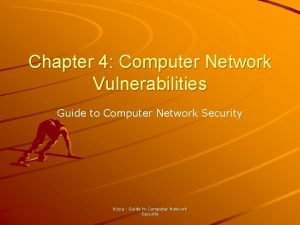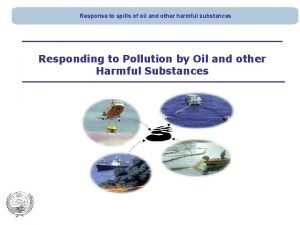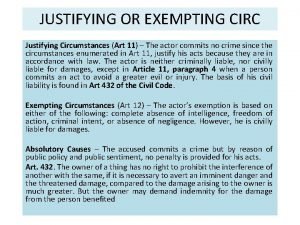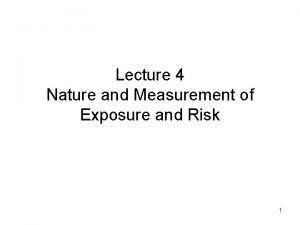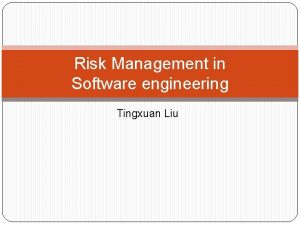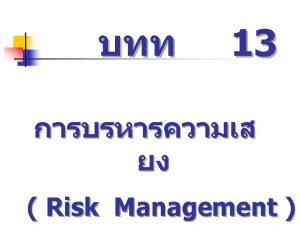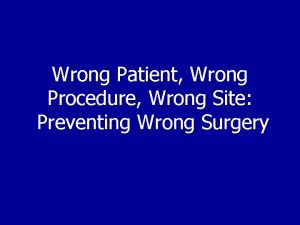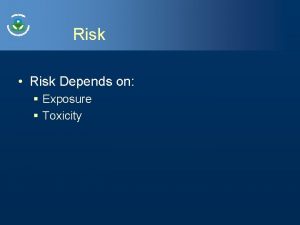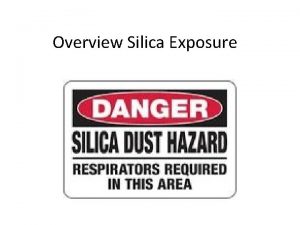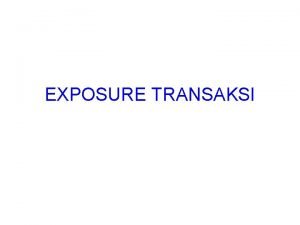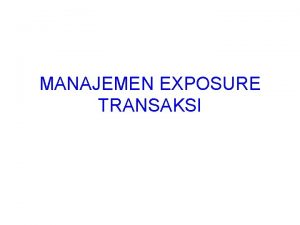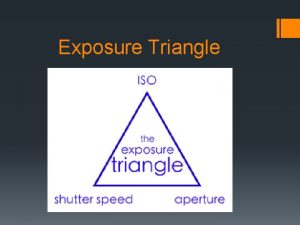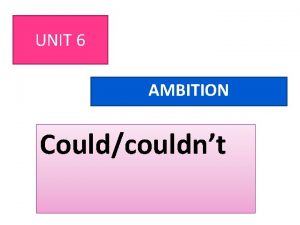What could go wrong Mitigating Risk Exposure and




























- Slides: 28

What could go wrong? ! Mitigating Risk, Exposure, and Loss in Charter Schools Thuy Wong, MPH, ARM President & CEO John Chino, ARM-PE, CSRM Area Sr. Vice President Public Entity Division

Operating a Safe and Sustainable School Goal: Give you the knowledge and tools needed to operate a safe and sustainable school in 3 key areas: (1) Financial - protecting against surprises negatively impacting budget (2) Reputational - enabling the school to retain good community standing (3) Physical - keeping students, staff, volunteers, and visitors safe

So, where would you even start? Risk Identification The Scholastic Risk Management Process The process of identifying and examining the potential sources of losses faced by the school The assessment of the potential impact that various exposures can have on the school Developed by The National Alliance for Insurance Education & Research Risk Control An action to minimize at optimal cost losses that strike the school Risk Financing The acquisition of funds at the least possible cost to pay for the losses that strike the school Implementation Risk Administration Implementing the desired actions and risk management plans Monitoring Examining and evaluating the results of risk management actions and plans Feedback Risk Management Process Analysis & Measurement

Types of Risks

School Examples

Break-ins & Thefts – Laptop carts Property Tree maintenance Water Damage Electrical maintenance

Employee Injuries - Falling from chairs, tables, and desks - Tripping over uneven surfaces, cords, backpacks Human Resources (Your Staff) - Getting hit by flying objects on playground - Mental stress/hostile environment - Cumulative trauma (ergonomics related) - Strains associated with lifting/pulling - Assault by students (biting!) - Dunk tanks - Staff retreats/disaster drills Employment Related - Discrimination in the workplace - Wrongful hiring and firing - Employee benefits management DOCUMENT!!!

Students and Others on Campus Students • Slips, Trips, and Falls • Ground conditions (uneven pavement) • Sports, playgrounds, PE • Bullying • Science lab, shop class, art classes • Field trips • Schools are immune from liability arising from field trips (Ed Code 35330) • Sexual Abuse Parents & Guardians Volunteer waiver Budget Containment Countersigned checks

Sexual Molestation Prevention 5 -Year Liability Claims: $18, 192, 395 Sexual Molestation Claims: $13, 495, 240 (74%) FACTS • One in four girls will be molested by age 18. • One in six boys will be molested by age 18. • The average offender molests 7 -8 minors and serial offenders may molest up to 400 minors. • Only 3 -4% of offenders are caught. • Background checks are not enough (3% impact). • Exponential litigation costs is driving insurers out of California – huge increase to premiums and less coverage 8 Ways to Create Their Fate: Protecting the Sexual Innocence of Children In Youth-Serving Organizations by Diane Cranley

Risk Identification The process of identifying and examining the potential sources of losses faced by the school Risk Control An action to minimize at optimal cost losses that strike the school Risk Financing The acquisition of funds at the least possible cost to pay for the losses that strike the school Implementation Risk Administration Implementing the desired actions and risk management plans Monitoring Examining and evaluating the results of risk management actions and plans Feedback Risk Management Process Analysis & Measurement The assessment of the potential impact that various exposures can have on the school

5 Methods to Control Risk Avoid the risk altogether Prevent the frequency of loss Reduce the severity or cost of loss Segregate Transfer Segregate to prevent one event from causing loss to the whole Transfer the risk (risk financing)

Examples Sexual abuse: boundaries policy, culture, training (prevent, reduce) Policy of no heels or open toed shoes on playground (prevent) Policy of no stacking chairs on top of desks to hang decorations on ceiling (prevent) Backup database systems in case of ransomware (duplicate to reduce) If elementary and middle school, separate lunch/recess (segregate) Contract with a food vendor for student lunches, custodial services, etc. with indemnity and insurance requirements (transfer) Buying insurance so the school does not have to budget millions for accidents, WC, etc. (transfer) Will not offer trucking education because it’s too risky (avoid)

Risk Identification The process of identifying and examining the potential sources of losses faced by the school Risk Control An action to minimize at optimal cost losses that strike the school Risk Financing The acquisition of funds at the least possible cost to pay for the losses that strike the school Implementation Risk Administration Implementing the desired actions and risk management plans Monitoring Examining and evaluating the results of risk management actions and plans Feedback Risk Management Process Analysis & Measurement The assessment of the potential impact that various exposures can have on the school

Risk Financing – More choices than you think! Risk Financing for Schools Transfer Retention 1. Insurance (Transfer) Non-Insurance (Transfer & Retention) Contractual Transfer Active (self-insurance) Passive (oops)

Hard Markets vs. Soft Markets? ? Insurance Companies are easily scared! • Soft Market: • coverage may be more readily available; premiums and deductibles may be lower and limits may be higher. • Hard Market: • the opposite is often true and some coverage may not be available at all.

Insurance Continuum Greater (school) Control Insured Drives Options Less (school) Control Insurer Drives Options Too Expensive!! Just Conventional Insurance Policy Right! Pool / JPA Shared Risk Too Risky!! Pure Self. Insurance Transfer Risk Retain Risk No Control

Pools & Educational/Scholastic Entities in CA 15% • % of public agencies that are in a pool: 85% 1% • % of public scholastic entities in a pool: 99% 20% • % of charters in a pool: 80%

LIABILITY PACKAGE $30, 000 per occurrence and aggregate Recommended Coverage Limits – Part 1 CRIME $1, 000 per occurrence Includes: General Liability, Educator’s Legal Liability (Professional Liability), Sexual Abuse Liability, Auto liability, Law Enforcement Liability, Employee Benefits Liability, Director’s & Officer’s Liability, and Employment Practices Liability PROPERTY Full Replacement Cost AUTO PHYSICAL DAMAGE $1, 000 per occurrence WORKER’S COMPENSATION statutory FIDUCIARY LIABILITY $1, 000 per occurrence EMPLOYER’S LIABILITY - $5, 000 per occurrence

Student Accident - $50, 000 per injury Volunteer Accident - $25, 000 per injury Recommended Coverage Limits – Part 2 Cyber Liability - $1, 000 per occurrence Pollution Liability & 1 st Party Remediation $1, 000 per ocurrence Terrorism Liability - $5, 000 per occurrence Terrorism Property – Full Replacement Cost

Risk Financing Transfer Retention 2. Insurance (Transfer) Non-Insurance (Transfer & Retention) Contractual Transfer Active (self-insurance) Passive (oops)

HOT POTATOES! Transfer Risk in Contracts/Vendor Relationships Common risk transfers to vendors: • Vendor Agreements • Activity Agreements Risks transferred to you: • Authorizing MOU • Lease Agreements Insurance and Indemnity

How to Allocate Risk • S/he who CONTROLS the risks presented by the activity should assume the risk. • This assumption of risk is outlined in the indemnity and insurance requirement portions of the contract. Both parties must be reasonable. • Don’t settle for inequitable terms. Unless the vendor is the only game in town, don’t be bullied!

Indemnity • INDEMNITY / HOLD HARMLESS AGREEMENT = One party assumes financial responsibility for the liability of another party via written agreement. • The duty to indemnify is broader than the duty to insure. • There may be exclusions in an insurance policy, or the policy may be canceled. • The party who controls the risk agrees to hold harmless and indemnify the party who is receiving the services/products (and is paying for the services/products) for liability arising out of the active negligence or willful misconduct of the party who controls the risk, unless the loss arises out of the active negligence or willful misconduct of the party who is receiving the services/products.

Insurance in Contracts The party who controls the risk: • Carry insurance coverages outlined within the contract • Provide a Certificate of Insurance showing proof of coverage • Provide an Additional Insured Endorsement to the school (party who receives the services/products) which defense the school and authorizer who they cause a lawsuit • Provide a Waiver of Subrogation for workers’ compensation • (If applicable) Provide a Loss Payee Endorsement for property

A. B. C. D. E. F. G. H. ★ Does “Insured” match the vendor’s name? Insurers – Do they have an A. M. Best’s rating of A-: VII or better? A = Financial Strength; VII indicates Financial Size (look online or ask your insurance representative) Type of Insurance – Does it fully match your request? Additional Insured, Waiver of Subrogation checked, or noted under Description? Are the Policy Effective dates current? If vendor is a small business, is proprietor excluded from Workers’ Comp? If yes, ask for a Waiver of Liability (similar to a Student Waiver Form) Description of Operations – Does it accurately reflect what the COI is intended to cover? Certificate Holder should include CMO and School(s) as applicable LIMITS


Risk Identification The process of identifying and examining the potential sources of losses faced by the school The assessment of the potential impact that various exposures can have on the school Risk Control An action to minimize at optimal cost losses that strike the school Risk Financing The acquisition of funds at the least possible cost to pay for the losses that strike the school Implementation Risk Administration Implementing the desired actions and risk management plans Risk Management Process Analysis & Measurement Monitoring Examining and evaluating the results of risk management actions and plans Feedback BEING AWARE, ACKNOWLEDGING, AND TREATING THE RISK IS THE BEST WAY TO KEEP A SCHOOL SAFE!

THANK YOU. Visit us at www. chartersafe. org Questions: Thuy Wong twong@chartersafe. org 949 -488 -2340 John Chino John_Chino@ajg. com 949 -349 -9827 28
 Managing economic exposure and translation exposure
Managing economic exposure and translation exposure Economic exposure
Economic exposure Managing economic exposure and translation exposure
Managing economic exposure and translation exposure Operating exposure vs transaction exposure
Operating exposure vs transaction exposure You put the wrong emphasis on the wrong syllable
You put the wrong emphasis on the wrong syllable Chapter 4 vulnerability assessment and mitigating attacks
Chapter 4 vulnerability assessment and mitigating attacks Market risk assessment
Market risk assessment Important things that happened in act 4 of romeo and juliet
Important things that happened in act 4 of romeo and juliet Examples of mitigating factors
Examples of mitigating factors Shipboard oil pollution emergency plan
Shipboard oil pollution emergency plan Justifying circumstances article 11
Justifying circumstances article 11 Nature of exposure and risk
Nature of exposure and risk Risk exposure index
Risk exposure index Risk exposure in software engineering
Risk exposure in software engineering Why risk can go wrong
Why risk can go wrong Residual risk and secondary risk pmp
Residual risk and secondary risk pmp Business risk vs financial risk capital structure
Business risk vs financial risk capital structure Relative risk
Relative risk Population attributable risk formula
Population attributable risk formula Risk projection attempts to rate each risk in two ways
Risk projection attempts to rate each risk in two ways Risk management avoidance
Risk management avoidance How to calculate relative risk
How to calculate relative risk Inherent risk vs control risk
Inherent risk vs control risk Absolute risk vs relative risk
Absolute risk vs relative risk Thinking algebraically stock market game answer key
Thinking algebraically stock market game answer key Medium-term risk examples
Medium-term risk examples Pembelanjaan resiko
Pembelanjaan resiko The biggest risk is not taking any risks
The biggest risk is not taking any risks Key risk indicators template
Key risk indicators template





